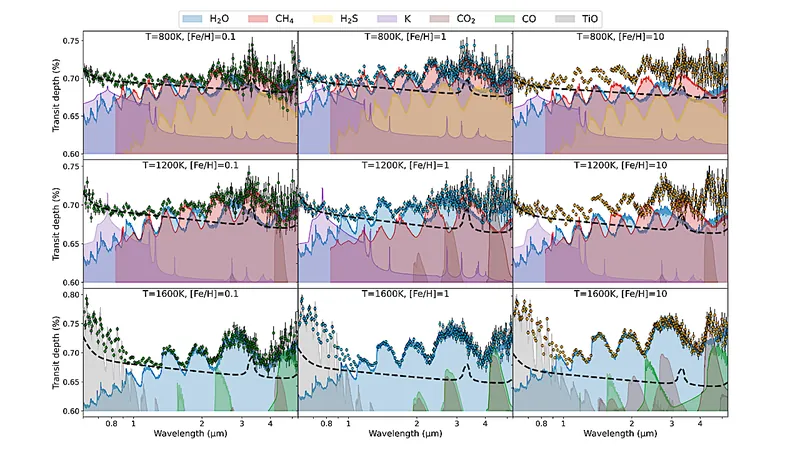
Exploring the Detectability of Polycyclic Aromatic Hydrocarbons in Exoplanet Atmospheres: Key Findings and Implications
2024-11-15
Author: Jacob
In a groundbreaking study, scientists have delved into the potential for detecting polycyclic aromatic hydrocarbons (PAHs) in the atmospheres of exoplanets, shedding light on the conditions favorable for such observations. This research aims to pinpoint the most promising exoplanets for future atmospheric investigations, particularly those that might host these complex organic molecules, which are crucial indicators of biological processes and planetary formation.
The team's primary focus was to establish the minimum detectable mass fractions of PAHs across a variety of planetary environments. To achieve this, they utilized a sophisticated combination of the one-dimensional self-consistent model, petitCODE, alongside the radiative transfer model, petitRADTRANS. This integrated approach allowed them to simulate the transmission spectra of selected exoplanets under various conditions.
In assessing observability, researchers harnessed the power of the PandExo noise simulator in conjunction with the NIRSpec PRISM instrument aboard the James Webb Space Telescope (JWST). This sophisticated analysis not only enhanced the accuracy of their findings but also provided a clearer roadmap for astronomers looking to detect these hydrocarbons in the vastness of space.
A pivotal part of the study utilized Bayesian analysis through MULTINEST code, which revealed that the detectability of PAHs is significantly affected by factors such as carbon-to-oxygen (C/O) ratios and the temperatures of the exoplanets. Remarkably, the findings indicated that planets exhibiting metallicity values of [Fe/H]=0 and 1, with C/O ratios around 0.55 and temperatures nearing 1200 K, stand out as the most promising candidates. These planets can yield detectable PAH mass fractions as low as 10^-7, equivalent to one-thousandth of the abundance levels found in the interstellar medium (ISM).
However, the study also noted that cooler planets with lower metallicities and C/O ratios, as well as hotter planets that possess carbon-dominated atmospheres, can reveal PAH presence at slightly higher abundance levels, approximately 10^-6. This nuanced understanding is essential for astronomers prioritizing which exoplanets to target in their future observations that could reshape our understanding of planetary atmospheres and the potential for life beyond Earth.
This research sets a substantial precedent for the selection of exoplanet targets, helping scientists design more effective observational strategies for studying PAHs, which not only serves to advance astrobiology and astrochemistry but also enriches our knowledge of the formation of complex organic molecules in environments beyond our solar system.
With further observation and exploration, the mysteries of the cosmos surrounding these exotic worlds may soon unlock secrets about life, chemistry, and the universe itself.
*Stay tuned for further updates as we continue to monitor developments in exoplanet research, revealing how close we might be to discovering life elsewhere in the universe!*









 Brasil (PT)
Brasil (PT)
 Canada (EN)
Canada (EN)
 Chile (ES)
Chile (ES)
 Česko (CS)
Česko (CS)
 대한민국 (KO)
대한민국 (KO)
 España (ES)
España (ES)
 France (FR)
France (FR)
 Hong Kong (EN)
Hong Kong (EN)
 Italia (IT)
Italia (IT)
 日本 (JA)
日本 (JA)
 Magyarország (HU)
Magyarország (HU)
 Norge (NO)
Norge (NO)
 Polska (PL)
Polska (PL)
 Schweiz (DE)
Schweiz (DE)
 Singapore (EN)
Singapore (EN)
 Sverige (SV)
Sverige (SV)
 Suomi (FI)
Suomi (FI)
 Türkiye (TR)
Türkiye (TR)
 الإمارات العربية المتحدة (AR)
الإمارات العربية المتحدة (AR)